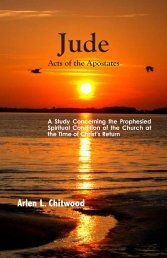Signs in John's Gospel - The Lamp Broadcast
Signs in John's Gospel - The Lamp Broadcast
Signs in John's Gospel - The Lamp Broadcast
You also want an ePaper? Increase the reach of your titles
YUMPU automatically turns print PDFs into web optimized ePapers that Google loves.
<strong>The</strong> Resurrection of Lazarus 189<br />
resurrection would have to be seen <strong>in</strong> the sign — both <strong>in</strong>dividual<br />
Israelites and national Israel — for there can be no nation, seen <strong>in</strong><br />
its completeness (“the whole house of Israel” [Ezek. 37:11]), apart<br />
from a bodily resurrection of Old Testament sa<strong>in</strong>ts to comprise<br />
and complete that nation.<br />
<strong>The</strong> resurrection of Lazarus foreshadows the nation be<strong>in</strong>g<br />
raised up to “live <strong>in</strong> his sight” two days (2,000 years) follow<strong>in</strong>g<br />
Abraham and two additional days (an additional 2,000 years)<br />
follow<strong>in</strong>g Christ’s appearance to Israel the first time (cf. Hosea<br />
5:15-6:2; John 11:6ff); and the resurrection of Lazarus, as well,<br />
foreshadows <strong>in</strong>dividual Jews who died <strong>in</strong> the faith dur<strong>in</strong>g Old<br />
Testament days be<strong>in</strong>g raised from the dead.<br />
Whether <strong>in</strong>dividual or national, the type body <strong>in</strong> which Lazarus<br />
was raised will be the type body which Israelites compris<strong>in</strong>g the<br />
nation will possess dur<strong>in</strong>g not only the Messianic Era but also<br />
throughout the follow<strong>in</strong>g eternal ages — a natural body of flesh,<br />
blood, and bones.<br />
Relative to <strong>in</strong>dividual Israelites, this is evident from that seen<br />
surround<strong>in</strong>g Lazarus’ resurrection when contrasted with Christ’s<br />
resurrection.<br />
<strong>The</strong> stone was rolled away to let Lazarus out of the tomb, and<br />
he came forth bound hand and foot with graveclothes, with a napk<strong>in</strong><br />
still cover<strong>in</strong>g his face.<br />
<strong>The</strong> stone cover<strong>in</strong>g the entrance to Christ’s tomb though was<br />
rolled away to let others <strong>in</strong> to see that He was already outside<br />
the tomb; and the empty, undisturbed graveclothes were still <strong>in</strong><br />
the tomb, ly<strong>in</strong>g exactly where Christ’s body had previously been<br />
(ma<strong>in</strong>ta<strong>in</strong><strong>in</strong>g the shape and contour of the body, apart from the<br />
body be<strong>in</strong>g on the <strong>in</strong>side), with the napk<strong>in</strong> previously cover<strong>in</strong>g His<br />
head hav<strong>in</strong>g simply collapsed where His head had been (Luke<br />
24:12; John 20:4-8).<br />
Lazarus was raised <strong>in</strong> “a natural body” of flesh, blood, and<br />
bones, capable only of that which natural man is capable of<br />
today. But Christ was raised <strong>in</strong> a different type body, one which<br />
Scripture calls “a spiritual body” (I Cor. 15:44), a body of flesh<br />
and bone, with the Spirit rather than the blood be<strong>in</strong>g the lifegiv<strong>in</strong>g,<br />
animat<strong>in</strong>g pr<strong>in</strong>ciple of the body. And this type body is



